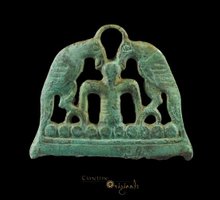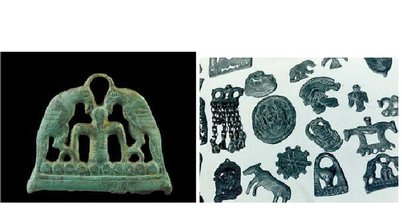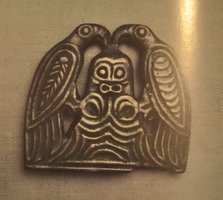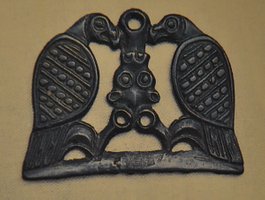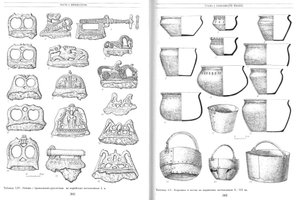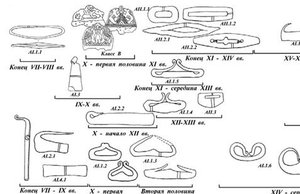Perm (Finno-Ugric tribes) animal style pendant or plaque amulet.
Sold as being:
'Extremely Rare Viking 'Odin and Ravens' Firesteel
Copper-alloy, 38.42 grams, 60.98 mm. Circa 9th-10th century AD.
A cast copper-alloy firesteel with iron striking surface below, bifacial with identical design to each face. The openwork handle is formed as a baseline of pellets upon which sit two birds of prey with detailed wings and eyes, their heads arched over a bearded male figure shown with his hands extended to the baseline, his broad shoulders emphasised and the bracelets on his wrists carefully modelled. Between the two birds' heads, a narrow band forms the suspension loop. The symbolism of the male between two birds of prey points to the god Oðinn (Odin) who gathered news by sending out two ravens, Huginn and Muninn, each day at dawn and listening to their reports in the evening.
Reference: cf Hammond, B. British Artefacts vol.2 - Middle Saxon & Viking, Witham, 2010 item 1.16-f. Very fine condition.
Provenance: from an old English collection, at one day..
Sergeij Upstad mailed me mailed me more than uptight, making me out for somewhat of a fool..
'... firesteels (steel is a key word here) were all made out of iron of high carbon content during the entire history of mankind. The bronze and other copper alloys are not strong enough to serve the purpose. What you have is a decorative anthropomorphic (combining elements of a man and animals or birds simultaneously) pendant or a plaque of Perm (Finno-Ugric tribes) animal style. Such decor pendants, plaques, clasps and belt ends served as amulets against evil spirits in medieval times..'
Addressed as being Permian animal style this would refer to the ancient history of Finno-Ugric peoples living west of the Urals – Zyrian Komis, Permian Komis and Udmurts – and their art, most frequently referred to as ‘the Permian animal style’.
It was at its prime from the 6th to the 8th and 9th c. and its end fell to the 14th c. Treating Permian art, we should bear in mind that the art of Ob-Ugrians is fairly similar to that of Permian peoples and that at the time there were also the Ob-Ugrians Mansis (or Voguls) living west of the Urals.
And indeed, as one searchs for 'Perm animal style' images, one stumbles upon an image (on the left beneath) wich depicts a similar artefact..
The drawings are from a Russian book, title unknownn (possibly: Sedov, B.B. Finno-Ugri i Balti v Epokhi Srednevekovija, Moscow, 1987.
A similar amulet / plaque is to be seen in the book:
Chudskie drevnosti Rifeia: Permskii zverinyi stil = The animal style of Perm (Iskusstvo Prikamia) (Russian Edition) (Russian) Hardcover – 1987
p. 67, plate 22.
So clearly being addressed to the X-XIth century, this is an artefact from the same period as the Viking Age, with a Odin and his ravens alike image but it might be some image known in Finno-Ugrian shamanism or a depiction of the ressurrection of Christ (or: soul flight). It is the question if the image of Odin and his two ravens destines from Viking mythology. Probably this cult/history originates in a much earlier stadium of Indo European culture. The figure of Odin is very much alike a shaman in Finno Ugrian mytholgie who communicates with his two birds between the world above and the underworld. Very well possible that the Vikings took over this image in a much earlier stageout of Finnic mythology and this image already was made in Finnic bronscasting excisted in the period of time before the Vikings. The two images on the right are from a book (very limited printed) called "Ugrian heritage".)
Note (July 28th 2021):
After years, someone revealed to me what the imagery of a person with two birds might represent. Birds: …’it's Mari origin. Thus it has something to do with the Mari mythology. It could be their God named Kugo-Yumo and the 2 birds are him and his brother Yin meaning they created the Universe turning into two drakes, or the birds are 2 giant eagles named Kuchkij like Turul in the Hungarian (Ugric) mythology’.
I asked myself a simple question: isn’t it time I ‘de-vikingize’ a bit and widen my knowledge beyond that of the Norse? I found that it is a lack of knowledge (and interest at first) about styles and mythology within the Finno-Ugric (language) area wich leads tot his (deliberate?) errors made in descriptions on this objects, seen from a ‘northern view’ or a ‘west European view’. I find it very hard to belief that who is interested in mythology, wouldn’t be interested in other area’s mythology. Studying this, we even have a possibility – as mentioned in the quote above – of an depiction showing either the one or the other. Once again: a human with two birds isn’t always Odin. A man with a beard depicted isn’t always Odin. By what means could we be 100% sure a depiction is Odin, by the way. Examples on artefacts are rare. We should embrace and appreciate an object on the atractiveness of its imagery to us, in the first place, not “flowering” it up with a mythological scene wich suits us best. Things can be totally different and most of all we will never know for 100% sure within this Norse or Finno-Ugric imagery. But we must broaden our view tot the unknown. I think it is our main goal in life.
Getting to know the full meaning of imagery can be problematic, ages after, but looking at an object wich is clearly depicting imagery with a purpose, we must give our best effort. Not only the artefact deserves it, its origin and meaning in its culture of origin deserves it.
It is the responsibility of any seller or dealer in artefacts, as it is crucial to its provenance, it is the responsibility of anyone interested looking at these kind of objects and who are at the turn of making a decision of aquiring an item. Care about the provenance of an item. It is the past, present and maybe most important, future, of any object, being hold privately and temporarely in our hand, or professional, within musea, visible or invisible tot he audience (in depots). If one doesn’t get engaged to these crucial aspects towards selling, collecting or – at one point – handing it over to another collector or museum, objects lose their true value.
Infatuated as many might be by Norse mythology and the vikings now – without ever knowing how this will be in future – we must be and stay concious to present and historical information connected to styles, imagery and so on. If we fail to do so, the objects will get disconnected from their origin and history. A history wich needs tob e preserved by all means. At least, we must die trying so.
Well. I could have been with these stones until after dark, but as my wife wanted to travel on.. well.. I see you again, some day, hogback stones from Gosforth. And if you happen to be there one day, do not forget that monument on the outside...
Further on with the Cumbrian hogbacktour !
In - yes, luckily again in - St. Peter's church in Heysham, there is a truly beautiful hogback stone. The guide told us, it had been studyied by Thor Ewing, a writer, in 2000. in 'Understanding the Heysham hogback' A tenth century sculpted stone monument and its context (link), Thor Ewing tells in detail what he dicovered on the both sides of this hogback stone.
Just being brought in the church as late as the 1970's accompanied with some protest here and there among the church visitors, considered as being a token of old paganism, it had been remarkably nice preserved, and a lot of detail can be seen, still. Truly worthwile a visit.
I had a small debate with the guide in the church if the - zoomorphic, in my opinion - faces on the sides were lions (or hippo's). The guide doubted if the vikings could have known about lions. Well I guess so, concerning the runes on the Ancient Greek lion statue at the Arsenal, Venice. For example. Vikings did travel south..
But when he told me he was doubting the vikings 'discovered' (as the native inhabitants were of course, in the first place) America before Columbus, I decided to rest my case..
One has to know when to start and to end a conversation ..
Just discovered the book in a bookstore written by Geoff Holder - The guide to the mysterious Lake District, I knew there had to be another hogback stone in Lowther, St. Micheal's Church. With a promising image described in the text of 'a naval and a land-based force of shield-bearing vikings above a fish and what might be a coiled sea serpent. On the reverse is a row of female figures with snakes, possibly a representation of the hideous hag Hel'. Wow. If that did not sound as a true pagan promised land ..
Not complaing too much after all we have seen, this visit was the dissapointing one of them all. But if you wife states 'I am happy to have seen them' and I am answering 'Measuring is knowing' and the even more obligate verb 'handling 'if we did not see it at all, we wouldn't have known anything at all of how they were looking' the glass was again half full, at the last day of our journey..
The hogback stone appeared to be just being tolerated within the entrance segment part of the church. As something you never use anymore but you do not throw away - entirely. That sort of feeling emerged when seeing this hogback asylum seekers.. Bed, bath and bread, ás we say in Dutch, but no luxury at all and standing on some outcuts of wood, you would balance the table with at home..
Come on, St. Micheal's Church.. care a bit more of your 'children' !
This hogback stone was moved in the church in 1907. Hogback stones layed partially buried in the churchyard before it was dug up and moved into the church.
The promising depiction of a longship - as certainly can be seen after some studying - see http://vikingminds.co.uk/pages/longship
we have missed !
The stone itself is (157 x 50 x 30 cm) and very worn.
The hogback stones in Cumbria - very diverse in quality, but everyone worth a visit ! Especially on a gloomy day in late October ...
The churches to visit - see photos of resp. St. Andrew's church in Penrith, St. Mary's church in Gosforth, St. Peter's church in Heysham and St. Micheal's church in Lowther.
Did I miss out on another one in Cumbria ? Let me know !
In a next blog I will take you to four - still remaining utterly mysterious- statues 'guarding' the graveyard of St. Andrew's church in Dacre..
For the last blog of October 9th see this link.
References: (as always, links to where the books can be ordered are attached).
Edwards, B.J.N. Vikings in North West England - The artifacts (1998);
Emery, Gordon, CURIOUS CUMBRIA, The Lake District & Beyond: A celebration of Cumbria (2023)
Ewing, T. 'Understanding the Heysham hogback' A tenth century sculpted stone monument and its context ;
Hall, R. Viking Age archaeology in Britain and Ireland (first printed 1990, reprinted with amendments in 1995);
Holder, G. The guide to the mysterious Lake District (2009)
possibly also (as there within the part of Cumbria dealing with Carlisle, the Eden Valley, Barrow-in-Furness, Whitehaven and the west coast is being dealed with)
Holder, G. Paranormal Cumbria (2010)
http://vikingminds.co.uk/pages/longship
